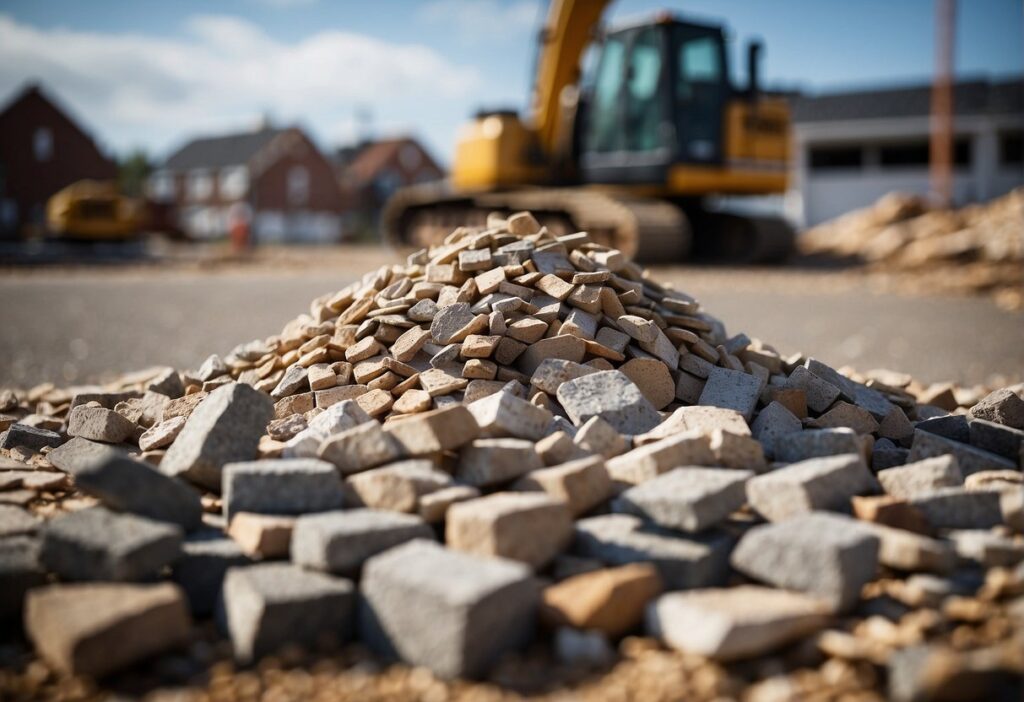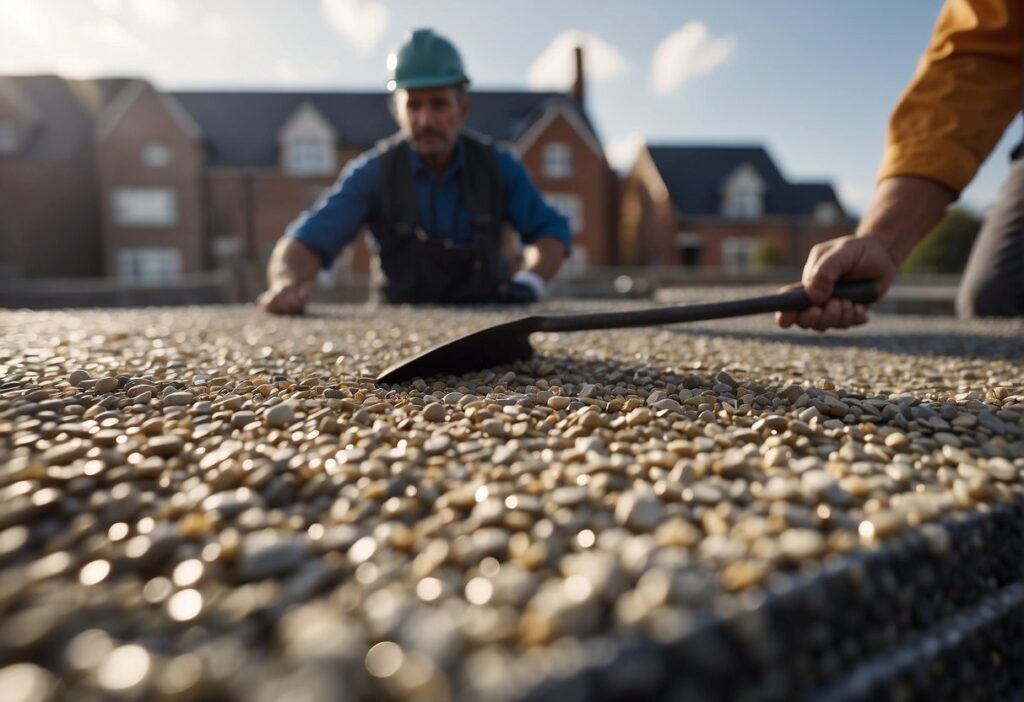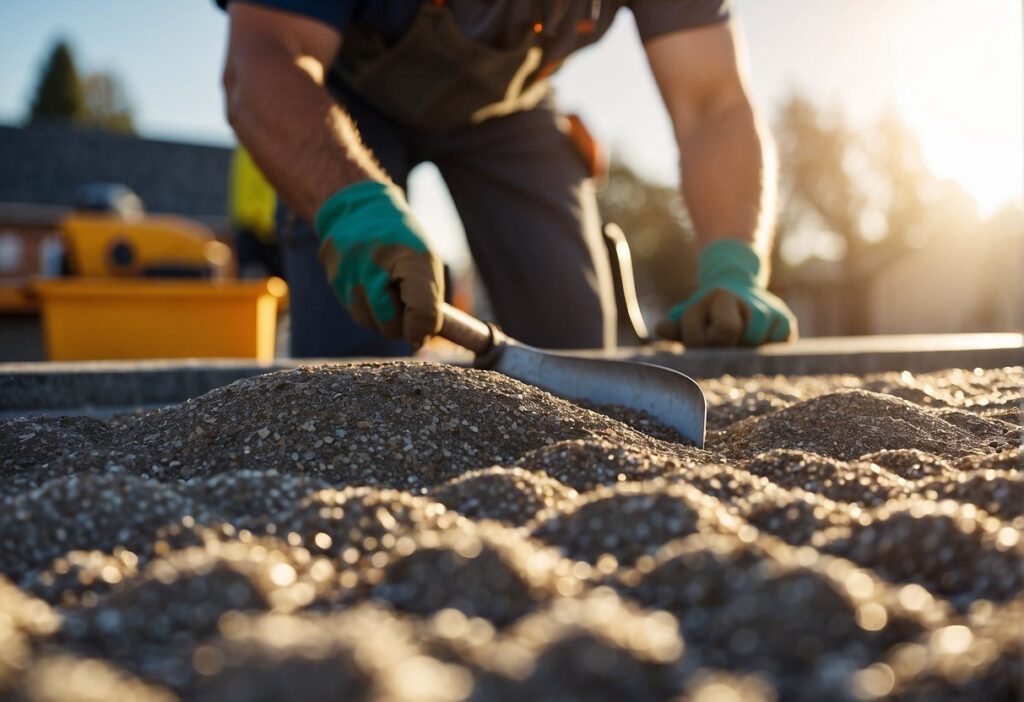Construction aggregates play a crucial role in the durability and performance of roofing systems across the UK. They encompass a wide range of materials such as gravel, sand, and crushed stone, which are vital components in the production of roofing materials. When combined with binding agents, aggregates contribute to the overall strength and weather resistance of roofing tiles, shingles, and other roofing components.

In selecting aggregates for roofing, it is paramount to understand the properties and suitability of different materials. For instance, the choice between lightweight aggregates for insulation purposes and heavier ones for structural integrity can significantly affect a roof’s lifespan and functionality.
Proper knowledge of aggregates also aids homeowners and roofing professionals in making informed decisions regarding maintenance and repairs, ensuring roofs are well-equipped to withstand the UK’s diverse weather conditions – many of the best Southport roofers for instance, are now having dedicated roofing teams in readiness for the high winds all along the coastline which borders on to the Irish sea.
Guidance on roof work suggests that employing the right type and combination of construction aggregates can extend the life of a roof, helping it to protect the structure beneath from the elements. With this in mind, selecting appropriate aggregates is not just about aesthetics; it’s a matter of safety and investment in one’s property.
Types of Roofing Aggregates

Roofing aggregates play a crucial role in the protection and aesthetics of a roof. They are selected based on their durability, weather resistance, and compatibility with roofing materials.
Slate Chips
Slate chips are a popular choice for roofing aggregates due to their ability to withstand harsh weather conditions. Their natural flatness leads to a tidy, streamlined appearance and they are often chosen for their longevity and attractive grey hues.
Limestone
Limestone aggregates contribute to a roof’s durability and can improve the overall lifespan of the roofing material. Used for their reflective properties, they can help to regulate building temperatures and reduce heat absorption.
Gravel
Gravel is a versatile aggregate commonly used in flat roofing systems. It helps to protect the underlying bitumen layers from UV rays and physical damage, thus extending the roof’s life.
Ceramic Granules
Ceramic granules are used in the manufacturing of asphalt shingles to protect them against ultraviolet light. They are available in various colours, aiding the visual appeal of shingles, in addition to offering functional benefits.
Benefits of Roofing Aggregates

Roofing aggregates are a key component in the construction and maintenance of robust and visually appealing roof systems. They offer a range of benefits that address durability, aesthetics, and thermal performance.
Durability Enhancement
Roofing aggregates contribute significantly to the longevity and resilience of roof coverings. By incorporating these materials, roofing systems are better equipped to withstand harsh weather conditions, from heavy rainfall to extreme temperatures. For example, slate chippings are known for their ability to resist cracking, which ultimately extends the life of the roof.
Improved Aesthetics
In addition to their practical advantages, aggregates can also enhance the visual appeal of roofs. They come in various colours, shapes, and textures, allowing for a high degree of customisation to complement different architectural styles. Utilising decorative aggregates for roofing can transform the overall look of a building, making it stand out in its surroundings.
Thermal Performance
The inclusion of aggregates in roofing systems can significantly improve a building’s insulation properties. Certain aggregates are effective in reflecting sunlight, which helps in maintaining cooler interior temperatures during hot weather. This thermal regulation contributes to energy savings by reducing the need for artificial cooling.
Application Techniques for Roofing Aggregates
Proper application of roofing aggregates is crucial for both aesthetic and functional aspects of a flat roof. Specific techniques ensure even distribution and lasting performance.
Hand Broadcasting
Hand broadcasting involves scattering aggregates by hand, a technique often used for smaller or intricate areas. Workers must wear gloves to protect their hands and maintain a consistent tossing motion to achieve an even spread. The depth of coverage is typically gauged by eye, making experience a valuable asset in this method.
Mechanical Spreading
For larger projects, mechanical spreading equipment can disperse aggregates more uniformly and efficiently. This approach uses machinery such as a broadcast spreader, which allows for precise control over the application rate. Operators adjust settings to suit the aggregate size and required coverage, ensuring a uniform layer across extensive roof surfaces.
Adhesive Binding
Adhesive binding secures aggregates to the roofing membrane. Initially, the application of a bituminous binder or liquid adhesive is necessary to create a tacky surface. Afterward, aggregates are applied before the binder sets. It is vital to achieve the correct adhesive thickness; too much can cause excess weight and poor adhesion, while too little risks inadequate coverage.
Standards and Regulations
In the UK, the roofing sector is guided by specific standards and regulations that ensure safety, quality, and environmental responsibility. These guidelines are critical for contractors, manufacturers, and homeowners to follow for compliant and effective roofing practices.
British Standards Compliance
British Standards provide the technical specifications and quality requirements necessary for a range of construction materials, including those used in roofing. Compliance with these standards helps ensure that materials such as roofing tiles, shingles, and insulation meet the necessary durability, performance, and safety criteria. The industry adheres to the BS 5534, the British Standard for slating and tiling, to ensure roofing materials can withstand the UK’s weather conditions and loading requirements.
Health and Safety Considerations
The health and safety of workers and residents are paramount in any construction project. Under the Health and Safety at Work etc. Act 1974, roofing contractors must manage risks associated with working at height, handling hazardous materials, and operating equipment. They must provide appropriate training, personal protective equipment, and conduct risk assessments to mitigate potential dangers. It’s obligatory for contractors to follow the Construction (Design and Management) Regulations 2015 (CDM 2015), which outlines the health, safety, and welfare obligations in construction.
Environmental Impact
The environmental impact of roofing materials and construction practices is regulated to promote sustainability and reduce the carbon footprint. Contractors must comply with the Construction Products Regulation in Great Britain, which outlines the environmental requirements for construction products. This includes ensuring materials are sourced responsibly and are recyclable or have minimal environmental impact at the end of their life cycle. Additionally, updates in building regulations encourage energy-efficient designs to reduce heat loss and incorporate renewable materials where possible.
Selection Criteria for Roofing Aggregates
The right selection of roofing aggregates plays a vital role in the longevity and performance of a roof. Here are some specific criteria to consider when selecting aggregates for roofing applications.
Aggregate Size and Shape
Selecting the appropriate size and shape of aggregate is crucial for roofing. Typically, a well-graded mix ensures a dense and effective coverage. Flat or elongated particles are often avoided as they do not interlock well, while rounded aggregates are preferred for promoting water runoff.
Colour and Texture Variability
The colour and texture of the aggregate can significantly affect the aesthetics of a building. A diverse range of colours, from natural browns and greys to pigmented options, allows for customisation to match or contrast with the surroundings. It’s important to ensure colour stability to prevent fading over time due to UV exposure.
Weather Resistance
Weather resistance is paramount for roofing aggregates. They must be able to withstand extreme climates, including resistance to freezing and thawing cycles. Resistance to wind erosion is also important, especially in exposed environments. One must choose aggregates with a proven track record of durability in similar climatic conditions.
Maintenance and Repair
Effective maintenance and timely repair of roofing aggregates are vital to the longevity and performance of a roof in the UK.
Regular Maintenance Routines
To ensure a roof’s durability, one should establish regular maintenance routines. A roof should be inspected at least twice a year, typically during spring and autumn, to identify any potential issues. During these inspections, homeowners should look for signs of aggregate displacement or wear, ensuring gutters and downpipes are clear of debris to prevent water pooling. A well-maintained roof can better withstand the UK’s variable weather, from heavy rainfall to sun exposure, which may otherwise lead to degradation of roofing materials.
Repairing Aggregate Loss
When it comes to repairing aggregate loss, timing and material matching are key. Any areas of visible aggregate loss should be addressed promptly to avoid further exposure to the roof’s underlayment or waterproof membrane. One should use the same type or a compatible aggregate for repairs to maintain consistency and performance – as further highlighted in the NFRC Homeowners Guide to Roof Work. If large areas of the roof are affected or if there is significant aggregate loss, it’s advisable to seek the expertise of a professional roofer.
Case Studies of Aggregate Use
In the realm of construction, aggregates play a pivotal role, particularly in roofing applications across both commercial and residential projects in the UK. They contribute to the durability and weather resistance of roofs, ensuring long-term structural integrity.
Commercial Building Projects
The Natural Environment Research Council provides an insightful example where aggregates are core to the construction of commercial buildings. In one case, they have been integral in concrete formulation, not just for the buildings themselves but also for the civil engineering structures that support them. Projects such as skyscrapers, shopping centres, and office blocks in the UK have seen aggregates used in mortars and finishes, enhancing the buildings’ ability to withstand environmental stress.
- Project: New Office Complex
- Location: Central London
- Aggregate Use: High-density aggregates for concrete roofing, providing soundproofing and weather resistance.
- Project: Retail Park
- Location: Manchester
- Aggregate Use: Lightweight aggregates for roof insulation, improving thermal efficiency.
Residential Roofing Examples
On the domestic side, recycled materials are rising in popularity due to their environmental and economic benefits. A case study highlighted by SEPA underscores the advantageous use of recycled aggregates, noting significant reductions in embodied carbon in the production of roofing materials. The use of recycled aggregates in residential roofing not only promotes sustainability but also offers cost advantages to homeowners through the lifecycle of their homes.
- Project: Eco-Friendly Housing Development
- Location: Glasgow
- Aggregate Use: Recycled aggregates used in roof tiles, reducing carbon footprint and cost.
- Project: House Renovation
- Location: Bristol
- Aggregate Use: Blended aggregates for roofing shingles, combining both aesthetic appeal and durability.
Future Trends in Roofing Materials
Industry trends indicate that the roofing sector is increasingly moving towards materials that are both environmentally friendly and technologically advanced. These materials are set to redefine the standards of durability and efficiency in roofing.
Sustainable and Recycled Materials
In the quest for eco-friendly construction, the UK roofing industry is seeing a shift towards the use of sustainable materials. These include options like green roofs, which incorporate vegetation, and recycled materials that minimise the environmental footprint of roofing. Recycled plastic and rubber are particularly popular, due to their durability and lower impact on the environment.
Technological Advancements
Roofing materials are also benefiting from technological advancements, such as solar-reflective surfaces that reduce heat absorption and cut energy costs. Innovations extend to new installation techniques that improve the lifespan and performance of roofs, ensuring that the advanced materials achieve their full potential in sustainable housing.
Latest form the Blog:
- How to Ensure Your Home Stands Strong Against the Elements: Essential Protection Tips
- The Role of Natural Materials in Modernising Home Interiors
- The Impact of Material Selection on Home Energy Efficiency: A Guide to Sustainable Living Choices
- Eco-Friendly Roofing: The Impact of Sustainable Aggregates on the Environment
- Comparing Roofing Aggregates: Slate Chips, Limestone, and Gravel Explained
